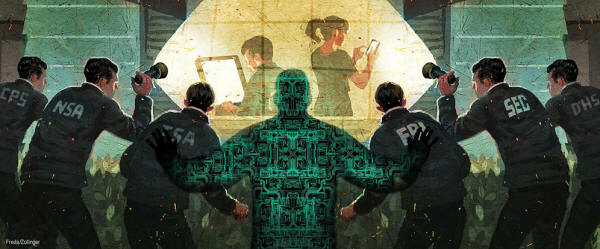|
from
ActivistPost Website
Total Information Awareness
June 23, 2016
the oppression, erosion of liberties, and invasion of privacy that has become the new norm for Americans, we must go back to the days following the terror attacks of September 11, 2001
Dubya's (slang term for the most inept president the United States has ever had - George "Dubya" Bush - source) program of "Shock and Awe" gave the American public an upfront look at what the U.S. military was prepared to do to the enemies of "freedom and democracy."
The bombing of Iraq was only the beginning of a larger
conflict that the Bush Administration dubbed "The Global War on
Terror."
Only 45 days after the 9/11 attacks, the U.S. Congress passed the infamous USA PATRIOT Act, typically known as simply the Patriot Act.
The full Orwellian title is the,
The Patriot Act dramatically expanded the U.S. government's abilities to monitor emails and landline phone calls, as well as also allowed access to voicemail through a search warrant rather than through a title III wiretap order.
There is also section 215 of the Patriot Act, which has been used to justify mass surveillance programs by the National Security Agency.
The Patriot Act also vastly increased the use of National Security Letters, a tool used by the government to force telecommunications companies to give customer information without the use of a warrant from a judge.
The NSLs are typically issued by the FBI to gather information from companies when related to national-security investigations. This information can include customer names, addresses, phone and Internet records, and banking and credit statements. The NSL also requires employees who have been questioned to be silenced via a gag order which prevents them from notifying anyone that the government is invading customers' privacy.
Interestingly, many Americans are unaware that the Patriot Act was in fact written before the attacks of 9/11 (see this and this).
Not only was the bill written and ready to be released at the right moment, at least one of the bills which spawned the Patriot Act was written by Vice President Joe Biden while he was still a senator in Delaware.
In 2008 CNET reported:
The advancing tyranny that has resulted from the Patriot Act, and the bills which preceded it, has led to what we see in America in 2016.
The bulk of American communications are now scanned, monitored, stored in a database, and analyzed for signs of terrorism. The NSA has even built a giant database in Utah to handle all of this data.
Big Brother and Big sister are listening through an array of devices:
While most Americans are familiar with the dangers and civil liberties violations of the Patriot Act, many may be ignorant to the other steps taken by the U.S. government in their misguided War on Terror.
In January 2002, the Defense Advanced Research Projects Agency (DARPA), an agency responsible for all of the exciting and terrifying emerging military technologies, established the Information Awareness Office (IAO).
The creation of the IAO was to bring together several DARPA projects that focused on using surveillance and data mining to track and monitor terrorists and other threats to U.S. National Security.
In November 2002, the New York Times reported that DARPA was developing a classified tracking program called "Total Information Awareness" (TIA), which was intended to detect terrorists by studying millions of pieces of data.
The program was designed to create huge databases to gather and store personal data from emails, social media, credit card records, phone calls, medical history, and online history, without the need for a search warrant.
The program also featured a biometric component that could be seen as a predecessor to the current FBI biometric database.
The Electronic Privacy Information Center said the goal of TIA was,
The man behind TIA was Vice Adm. John M. Poindexter, the former national security adviser in the Reagan administration, who was convicted in 1990 for his role in the Iran-contra affair.
Poindexter's conviction would later be overturned by a federal appeals court because he was granted immunity in exchange for testifying about his wrongdoing. Poindexter argued that the U.S. government must be granted even more powers than were given in the Patriot Act.
In 2002, The NY Times reported that Poindexter believes,
Poindexter's actions were criticized by many computer and security experts, including Barbara Simon, a computer scientist and past president of Association of Computing Machinery, who foreshadowed the coming Surveillance State with a warning that,
Public criticism of the TIA would grow so loud that Congress was forced to defund the entire IAO in 2003.
However, many Americans correctly suspected that the programs were still being developed, only under different names, using different agencies. This fact would later be confirmed by Edward Snowden's surveillance leaks of 2013.
However, for those paying close attention, it was known for at least 7 years before the Snowden leaks.
In 2006, the National Journal obtained documents which they said proved that the TIA had been moved from DARPA to another group which focused on building spying technology for the National Security Agency.
The Journal outlines how the system was moved and renamed.
In 2002 the consulting firm Hicks & Associates, reportedly run by former Defense and military officials, was awarded a $19 million contract to build the prototype for TIA.
Internal emails obtained by the Journal show Hicks executive, Brian Sharkey, informing his employees of the name change.
Another e-mail reminded the company's staff that,
The Journal also pointed out that another TIA project known as Genoa II was renamed Topsail and moved to ARDA.
Genoa was focused on pre-empting crime, an early predecessor for pre-crime technologies.
When attempting to question the Senate Intelligence Committee about whether or not the TIA's programs were simply renamed and moved, Senator Ron Wyden of Oregon told by Director of National Intelligence John Negroponte and FBI Director Robert Mueller that they didn't know.
However, Negroponte's deputy, Gen. Michael V. Hayden, said,
Hayden would go on to become the director of the Central Intelligence Agency and director of the NSA among other spy agencies.
Finally, in 2013, even the magazine Scientific American was forced to acknowledge that the Total Information Awareness never ended. Edward Snowden had made it perfectly clear by that point that Americans are living in a Surveillance State.
In fact, in an interview with WIRED, intelligence analyst James Bamford said the NSA's $2 billion facility in Utah,
Welcome to the Age of Total Information Awareness.
A place where free people of the world voluntarily give up what little bit of privacy they maintain via social media tags, check ins, and constant self-surveillance.
If you care about privacy (and you should if you care about freedom) then it's time to start openly resisting the prying eyes and ears of the State and begin investing in new technologies that can disrupt the spying and protect our private lives.
The Patriot Act II
we must examine past attempts to destroy liberty in the name of security. To understand where we are today we must understand what might have been. In this Part 2 of this series we take a look at the infamous Patriot Act II.
In the days following the 9/11 attacks the U.S. Congress moved quickly to pass their Orwellian bill the "Uniting and Strengthening America by Providing Appropriate Tools Required to Intercept and Obstruct Terrorism Act of 2001," or simply, the Patriot Act.
The Patriot Act dramatically expanded the U.S. government's abilities to monitor emails and landline phone calls, as well as allowed access to voicemail through a search warrant rather than through a title III wiretap order.
There is also section 215 of the Patriot Act, which has been used to justify mass surveillance programs by the National Security Agency.
While you may be familiar with the dangers and civil liberties violations of the Patriot Act, you may not remember a second threat to freedom launched by the Bush Administration shortly after the passage of the first Patriot Act. In early February 2003, the Center for Public Integrity obtained a draft of previously unreleased legislation known as the Domestic Security Enhancement Act of 2003, or the Patriot II, as it came to be known.
The bill was drafted by the staff of John Ashcroft, who was serving as Attorney General at the time.
At the time of the release of the text, the bill had reportedly only been seen by a handful of people, although rumors of an update to the Patriot Act had been swirling around D.C.
However, an Office of Legislative Affairs "control sheet" that was obtained by the PBS program NOW with Bill Moyers seems to indicate that a copy of the bill was sent to Speaker of the House Dennis Hastert and Vice President Richard Cheney on Jan. 10, 2003.
The draft of the bill was immediately criticized as an expansion of the already invasive powers granted to the Bush Administration in the first Patriot Act.
Dr. David Cole, Georgetown University Law professor and author of Terrorism and the Constitution, told the Center that the Patriot II bill,
Following the disclosure of the draft, Barbara Comstock, director of public affairs for the Justice Dept., released a statement saying that,
The American Civil Liberties Union outlined some of the most egregious changes proposed in the draft of the Patriot II.
For example, Section 301-306 would have created a "Terrorist Identification Database," a DNA database for suspected terrorists.
Here are a few of the other changes proposed by the Domestic Security Enhancement Act of 2003:
Thankfully, public criticism of the Patriot II was so great that the bill never really gained traction and by the end of 2003 had completely fallen out of favor.
However, as The Washington Times noted,
As we showed in part 1 above, provisions like Total Information Awareness and the Patriot II were still eventually developed - only under different names, using different agencies.
One provision of the Patriot II that was quickly adopted under a different bill relates to the government's use of a tool known as National Security Letters.
The Patriot Act vastly increased the use of National Security Letters, a tool used by the government to force telecommunications companies to give customer information without the use of a warrant from a judge.
The NSLs are typically issued by the FBI to gather information from companies when related to national-security investigations.
This information can include customer names, addresses, phone and Internet records, and banking and credit statements. The NSL also requires employees who have been questioned to be silenced via a gag order which prevents them from notifying anyone that the government is invading customers' privacy.
In late 2003, Congress voted in favor of an intelligence bill that included a provision which expanded the power of NSLs. The provision was directly out of the text of the Patriot II.
In November 2003, Wired reported:
Chris Schroeder, a Duke law professor and former assistant attorney general in the office of legal counsel at the Justice Department, told Wired that the "re-insertion" of the provision showed that,
Some of the darkest elements of the Patriot II would be codified into law in late 2011, when President Obama signed the National Defense Authorization Act, complete with provisions allowing indefinite detention of Americans.
Indeed, much of the plans of the Patriot II are now common activities of local, state, and federal law enforcement. The bulk of American communications are now scanned, monitored, stored in a database, and analyzed for signs of terrorism.
The NSA has even built a giant database in Utah to handle all of this data.
Big Brother and Big sister are listening through an array of devices.
It starts on the individual level in our hearts and minds, and it continues in our communities.
It's up to each of us to begin taking steps in our own lives to create the world that we wish to see.
|



